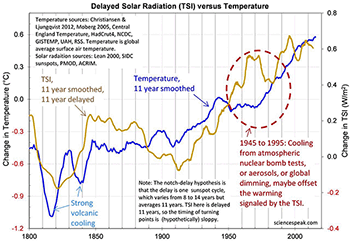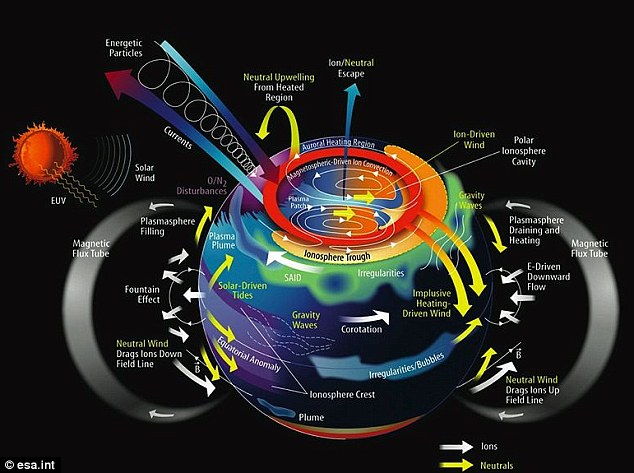The correlation between temperature and the length of the previous sunspot cycle (“solar cycle”) is one of the strongest correlations in climate science, unexplained to date and largely disregarded, but the notch-delay hypothesis offers support and explanation.
Friis-Christensen and Lassen (1991, [SUP]
[4][/SUP]) found that the length of a sunspot cycle correlates well with the northern hemispheric surface temperature on land during the
following sunspot cycle — the longer a sunspot cycle, the cooler the Earth during the following sunspot cycle — from 1861. (The correlation is strong to 1970 in their data then there is a dispute. Damon and Laut (2004, [SUP]
[5][/SUP]) claim they mishandled their data and that the correlation from 1970 instead predicted level temperatures while in fact they went up strongly, thereby breaking the correlation and supporting the CO2 theory. However this is strongly disputed by
Friis-Christensen and Svensmark (2004).)
Butler and Johnston (1994, [SUP]
[6][/SUP]) found the correlation applied to temperatures at the Armagh observatory in Northern Ireland from 1795.
Archibald (2010) showed the correlation applied to the 350 year Central England temperature record, the De Bilt data from Holland, and temperature records at a number of places in the northeastern USA: “in the latter, the relationship is that each 1-year increase in solar cycle length corresponds to a 0.7°C decline of atmospheric temperature during the following cycle”. David Archibald also proposed using the correlation as a predictive tool. He has been championing this correlation in recent years.
The duration of the ascending part of a sunspot cycle (roughly its first half) is anti-correlated with the peak sunspot number of the cycle, which is known as the Waldmeier effect. However the strength of this negative correlation depends strongly on the measure of the rise time and which index of sunspot numbers is used (Dikpati, Gilman, and de Toma, 2008, [SUP]
[7][/SUP]). Higher sunspot numbers correlate with a higher peak of TSI, so from the Waldmeier effect we deduce that a longer sunspot cycle correlates with lower levels of TSI during the cycle, which correlates with lower surface temperatures during the following sunspot cycle.
Thus lower TSI during one sunspot cycle correlates with lower surface temperatures during the next sunspot cycle. The delay implied by this correlation is roughly one sunspot cycle, or ~11 years.
Note also that the existence of the correlation supports the notion that the Sun has a major influence on temperatures.
- Delay of 10–12 Years to Surface Temperatures in Norway and the North Atlantic
Solheim, Stordahl, and Humlum (2012, [SUP]
[8][/SUP]) found that a lag of 10–12 years gives the maximum correlation between sunspot cycle length (SCL) and surface temperatures in Norway and the North Atlantic, from 1880: “This points to the Atlantic currents as reinforcing a solar signal.”; “it is reasonable to expect a time lag for the locations investigated, since heat from the Sun, amplified by various mechanisms, is stored in the ocean mainly near the Equator, and transported into the North Atlantic by the Gulf Stream to the coasts of Northern Europe”; “They also found that temperatures shifted 11years back in time, correlated better with SCL measured between minima than between maxima.”
Recent History Suggests a Delay
Lockwood and Froehlich (2007, [SUP]
[9][/SUP]) found that four measures of solar activity — sunspots, TSI, coronal source flux, and neutron count due to high energy cosmic rays — all peaked around 1986 and 1987 after rising since at least 1970, once the usual fluctuations of the sunspot cycle were removed by a smoothing process. Global surface temperature rose until peaking in 1998 (or maybe 1997 if the effect of the 1998 El Nino is smoothed out), before leveling off.
This suggests a delay of ~11 years from changes in TSI to corresponding changes in surface temperatures. Indeed,
without a delay it is difficult to see how TSI could be signaling the major influence on the surface temperature. (The Lockwood and Froehlich paper is often held by the establishment as evidence for the
lack of solar influence on global temperature.)
Observations are Suggestive of a Delay . . .  Solar
Solar 




